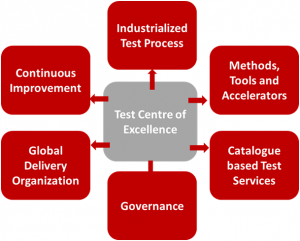SIX CORNER STONES OF A TEST CENTER OF EXCELLENCE
June 25, 2014
 Many companies have started their journey for setting up a Test Center of Excellence. They also allocate more of the overall IT Budget on increasing the quality on the applications. A Test Centre should be responsible for some of the IT Departments goals for delivering measurable improvements in quality, faster time-to-market, cost reduction and more efficient IT operational processes.
Many companies have started their journey for setting up a Test Center of Excellence. They also allocate more of the overall IT Budget on increasing the quality on the applications. A Test Centre should be responsible for some of the IT Departments goals for delivering measurable improvements in quality, faster time-to-market, cost reduction and more efficient IT operational processes.
To build a successful Test Centre of Excellence the following corner stones need to be in place:more–>
Industrialized Test Process
The test process must be structured, with predefined phases. This process should be followed by all projects. The test process must be adapted into other processes in the company (software development process, deliveries from suppliers, etc.) The testers should feel familiar with the established process and training is important.
The goal of an industrial process is to facilitate efficient deliveries with higher test coverage.
Methods, tools, and accelerators
The Test Center’s method should describe how testing should be carried out with a strategy, procedures, templates, techniques and tools. These must be available and followed by all.
Catalogue Based Testing Services
There is a clear advantage if the Test Center’s tasks are offered as testing services where the (internal and/or external) customers of the Test Center order according to what they need, and not a named person – “I need Anna to do this testing since she is the only one with this special competence…”. This ensures that the focus is on competence management, and dependency on key resources will be lower. Examples of services: test management, creating and maintaining test scripts (manual and automated), functional testing, performance testing, security testing, test environment management, test data, etc.
Governance Model
It is recommended to establish a governance model for the Test Center. Since test and quality activities allocate a larger part of the IT budget it is important to show that the investment leads to faster time to market, cost reduction, improved quality, and better risk management.
As part of the governance model, it is advisable to establish the Test Center with an SLA structure, either for the unit as a whole and/or for each service from the service catalog. It also smart to define a set of strategic KPIs and/or tactical KPIs.
(Global) Delivery Organization
Test activities for the projects can be organized in test lines per domain/product. The test line consists of one core test team, with special knowledge on the domain/product and can be extended with flexible test resources when needed – either when it is a peak or special testing competence is needed. This enables a standard way of testing, and the resources can be utilized in a more efficient way. Because all test lines use the same industrialized basis for test processes and test tools, new test lines will be operational at short notice, and will profit from advantages of economies of scale with immediate operational flexed capacity. By organizing the testing in this way it is also possible to have a global team and offshoring (some of the) test lines.
Continuous improvement
A Test Center should regularly measure their test maturity and have plans for continuous improvements. The process should be formalized with assessments where the team agrees on pain points and improvements that should be delivered during the next coming period.

 English | EN
English | EN 